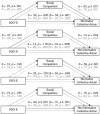Social Dominance Orientation Boosts Collective Action Among Low-Status Groups
- PMID: 34177735
- PMCID: PMC8226091
- DOI: 10.3389/fpsyg.2021.681302
Social Dominance Orientation Boosts Collective Action Among Low-Status Groups
Abstract
We propose that low-status group members' support for group-based hierarchy and inequality (i.e., social dominance orientation; SDO) may represent an ideological strategy to guarantee the legitimacy of future ingroup status-enhancement. Specifically, we argue that, under unstable social structure conditions, SDO serves as an ideological justification for collective action tendencies aimed at competing for a higher status. In such context, SDO should be positively related with actions aimed to favor the ingroup (i.e., collective actions) by increasing group members' motivation to engage in direct competition with a relevant higher-status outgroup. We conducted two studies under highly competitive and unstable social structure contexts using real life groups. In Study 1 (N = 77), we induced Low vs. High Ingroup (University) Status and in Study 2 (N = 220) we used competing sports groups. Overall, results showed that, among members of low-status groups, SDO consistently increased individuals' motivation to get involved in actions favoring the ingroup, by boosting their motivation to compete with the opposing high-status outgroup. We discuss the results in light of the social dominance and collective action framework.
Keywords: collective action; social competition; social dominance orientation; social identity theory; unstable social hierarchies.
Copyright © 2021 Carvalho, Pinto, Costa-Lopes, Páez, Miranda and Marques.
Conflict of interest statement
The authors declare that the research was conducted in the absence of any commercial or financial relationships that could be construed as a potential conflict of interest.
Figures


Similar articles
-
Intergroup Contact Effects via Ingroup Distancing among Majority and Minority Groups: Moderation by Social Dominance Orientation.PLoS One. 2016 Jan 11;11(1):e0146895. doi: 10.1371/journal.pone.0146895. eCollection 2016. PLoS One. 2016. PMID: 26751203 Free PMC article.
-
The nature of social dominance orientation: Theorizing and measuring preferences for intergroup inequality using the new SDO₇ scale.J Pers Soc Psychol. 2015 Dec;109(6):1003-28. doi: 10.1037/pspi0000033. Epub 2015 Oct 19. J Pers Soc Psychol. 2015. PMID: 26479362
-
Favoring Inequalities and Mind-Reading: Social Dominance Orientation Relates to Poor Mentalizing.Psychol Rep. 2025 Aug;128(4):2518-2529. doi: 10.1177/00332941231173877. Epub 2023 Jul 21. Psychol Rep. 2025. PMID: 37478167
-
The role of group-based egalitarianism in collective action.Curr Opin Psychol. 2020 Oct;35:108-113. doi: 10.1016/j.copsyc.2020.05.009. Epub 2020 Jun 9. Curr Opin Psychol. 2020. PMID: 32629395 Review.
-
When Social Hierarchy, Power, and Collective Autonomy Motivate Social Movement and Counter-Movement Mobilization Among Disadvantaged and Advantaged Groups.Pers Soc Psychol Rev. 2025 Jan 9:10888683241305662. doi: 10.1177/10888683241305662. Online ahead of print. Pers Soc Psychol Rev. 2025. PMID: 39781666 Review.
Cited by
-
Brexit and Trump: Which Theory of Social Stasis and Social Change Copes Best With the New Populism?Front Psychol. 2022 May 26;13:797139. doi: 10.3389/fpsyg.2022.797139. eCollection 2022. Front Psychol. 2022. PMID: 35719587 Free PMC article.
References
LinkOut - more resources
Full Text Sources

